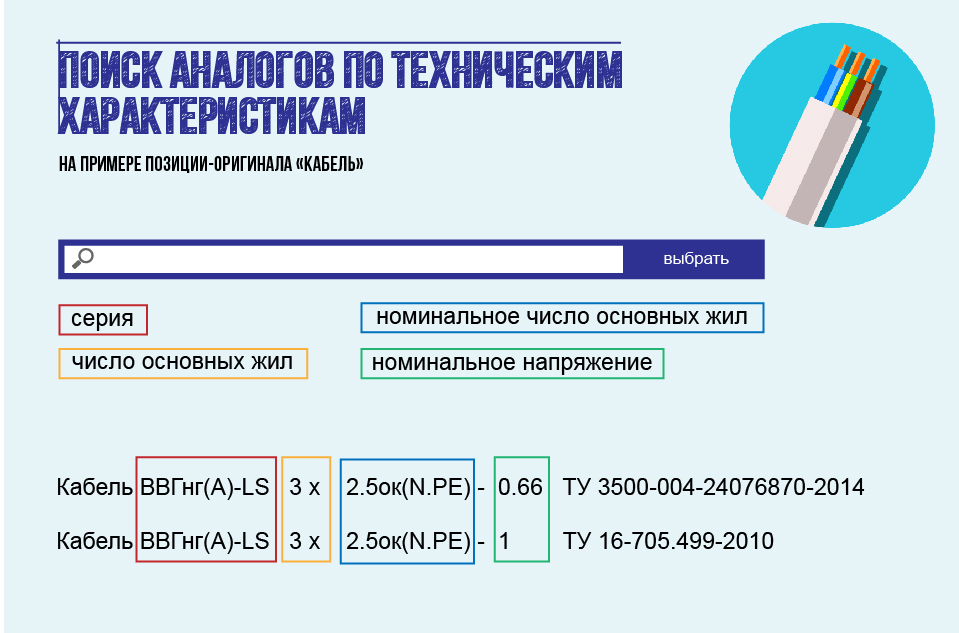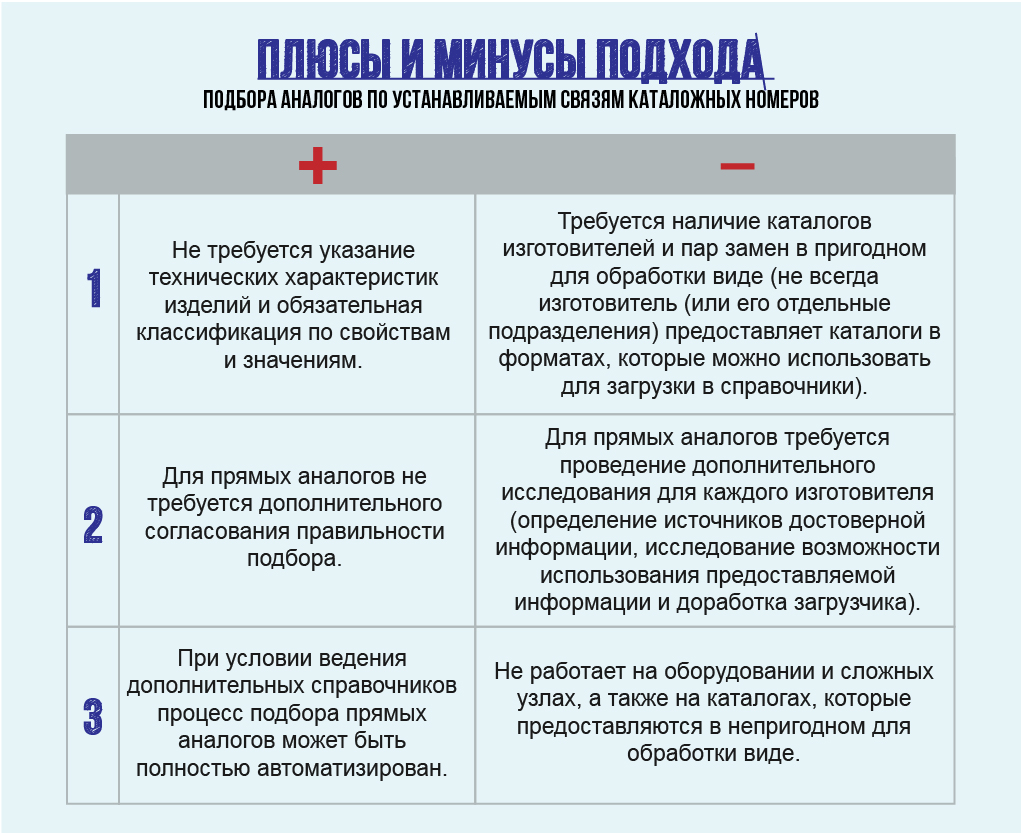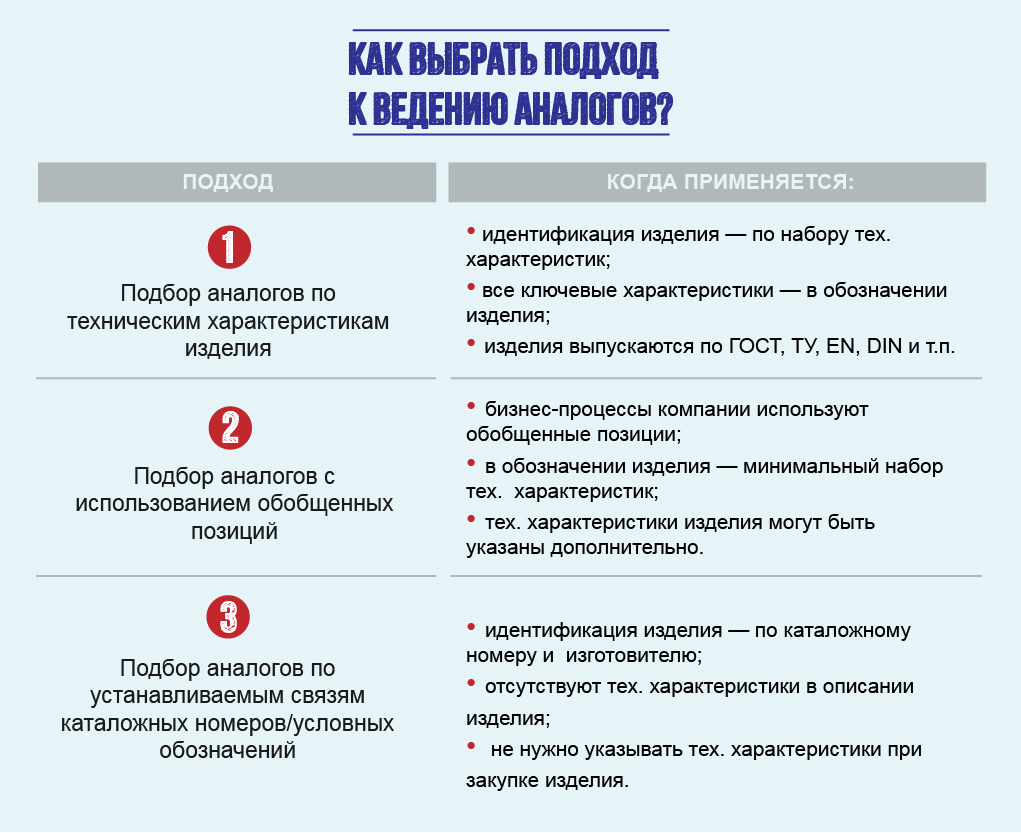Analogs in the "Nomenclature". Another way to save wisely. Part 1
What are analogs and how should (and should not!) Lead them
In the last article I told how to save the time and money of the Customer, refusing the primary normalization of reference books. It was about the "Nomenclature", the initial cleaning of which requires a lot of project time and does not bring the expected results.
What next? Is it possible to make work with the nomenclature even more profitable, especially for large-scale production?
Yes, and to do this will help correctly built work with analogs - nomenclature positions, which fully or partially coincide in characteristics and purpose with the original, but have an excellent or outdated designation.
It is analogs that are able to reduce the valuable downtime of equipment in large-scale production and reduce the cost of an enterprise for the purchase of new item positions up to 50%.In this part I will tell you what analogs are and how it is worth (and not worth it!) Them. And in the next - I will share the project experience, which brought the customer the long-awaited benefit, saving you from unnecessary expenses and equipment downtime.

What is the "Nomenclature" in large-scale production and where are the analogues?
“Nomenclature” in production is a voluminous, many thousands directory of names of goods, products, types of equipment, etc., which is constantly updated in accordance with the needs of the enterprise.
In the production of such a reference book plays a key role, because according to the data of this catalog, the system of procurement of the parts, components and equipment necessary for the production is built.
So, according to the experience of our Customers, each simple unit critical for the production of machinery in an enterprise can result in a company losses of about 2-3 million rubles a day!Idleness can be avoided by replacing the part in time. For such a replacement, and refer to the directory "Nomenclature". After normalization, this directory will keep relevant and consistent information: without duplicates and outdated positions.
But for the operational and economical operation of the enterprise, for example, after the described breakdown, it is important to have information of another nature in the directory:
• availability of interchangeable parts / goods in the company's warehouses;
• about similar items that can be bought at a better price.
Such parts and products are analogues.
What are analogs?
All analogues can be divided into:
• direct analogues , information about which is maintained by the manufacturer;
• indirect analogues , information about which can be provided by a qualified technical specialist of the enterprise.
What are the approaches to maintaining analogs in the "Nomenclature" directory?
The generally accepted approaches to the search and maintenance of analogs are conventionally reduced to three main areas:

1. Search and maintenance of analogues according to product specifications:
The essence of the method: for the original is selected a set of positions-analogues of the originally established criteria.
Example: For the original position “Cable VVGng (A) -LS 3x2.5ok (N, PE) -0.66 TU 3500-004-24076870-2014”, as a candidate for the indirect analogue can be proposed: “Cable VVGng ( А) -LS 3х2,5ок (N, PE) -1 ТУ 16-705.499-2010 ”, if the selection will be carried out according to the same parameters:
• series (VVGng (A) -LS);
• material lived (copper);
• insulation material (PVC);
• and so on.

How the legality of replacement is determined: the legality and conditions of replacement are determined by the results of the examination.

Example of life: errors in maintaining analogs of the technical characteristics:
Two positions with a coinciding set of certain technical characteristics can be considered as analogs in some conditions and not in other conditions.
For example, for the original cable, following this approach, an analogue was found, which coincides with it on the material of the cores, insulation, shell, the number of main cores and their sections, on the value of the nominal voltage. Only after laying such an analogue cable did it become clear that the additional property was not taken into account - the level of smoke emission and corrosive and toxic combustion products. This property during operation in the office is very important from the point of view of fire safety. As a result - the alteration of the screed, plaster walls and ceiling => costly repair of the entire office building.
2. Selection of analogues using generalized positions:
The essence of the approach: the approach is based on the presence in the directory "Nomenclature" of generalized records and correlated generalized positions attached to them, or specific records of "Nomenclature".
Generalized position - nomenclature entry without specific characteristics or with an incomplete set of characteristics. The generalized position corresponds to several specific nomenclature records.
Example: the “Monitor for computer” entry will be a generalized position to which other similar entries in the directory will be attached. If it is necessary to promptly replace any parts or equipment, they will be selected from parts / equipment of generalized grouping.

How is the validity of the replacement determined:the possibility and conditions of replacement within the same group of generalized positions are determined by the results of the examination.

Life example: errors in maintaining analogs using generalized positions:
Following the approach, for the selection of an analogue to the original Voyager 2N GLONASS car tracking system, this group was found with generalized positions that included the original:
• Car tracking system;
• Voyager 2N tracking system;
• Tracking system TK-103B.
As a substitute analog, it was decided to use the tracking system TK-103B, since the position is uniquely identified and belongs to the same group with generalized positions as the original.
After dismantling the old system and installing a new one, it turned out that the analog does not meet the requirements specified in the order No. 285 of the Ministry of Transport of the Russian Federation of July 32, 2012 (the original allows using GLONASS, and the analog is only GPS). Therefore, the analogue can be used to equip personal vehicles, but it cannot be installed on route vehicles transporting passengers: buses and route taxis, as well as on transport transporting dangerous goods.
3. Selection of analogues by catalog numbers:
The essence of the approach: the approach does not depend on the technical characteristics of the nomenclature record, but is determined only by the links that are automatically or manually created and stored in the NSI Management System.
Example: With this approach, separate tables are created in the System for maintaining the NSI to store information about analogues, for example, like this:

According to these tables, the selection of analogues is done automatically, and the tables themselves are updated with relevant data by technical specialists.
How the legitimacy of the replacement is determined: direct analogs are maintained, as a rule, automatically; indirect ones are maintained manually by a technical specialist.

Errors in maintaining analogs on links of catalog numbers:
In this direction, to be honest, I have not yet met with specific examples of errors. But even here the human factor is not excluded - there is always the likelihood of incorrectly specifying a bundle of original-analogue even at the level of sources of official information, such as manufacturers' sites.
From all the described errors one can be protected only by one’s own expertise within the organization in different nomenclature groups.
How to choose the approach to maintaining analogs?
Which approach to managing analogs will be chosen in a particular company depends on various criteria. For clarity and ease of understanding, the criteria are placed in the table:

So, there is no single and universal way of doing analogs, but there are three leading directions, having studied which, you can competently use in organizing work with the “Nomenclature” of production. How to do it: combine several directions or apply one thing - the choice is yours!
And in the next part I will tell you how we have automated the maintenance of analogs in the enterprise, and how this affected the customer’s finances.
PS And another special thanks to the marketing and design department, without their illustrations in such a huge topic and you will not understand :)
